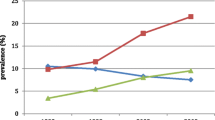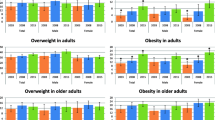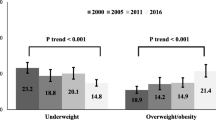Abstract
Objective
This study is a systematic analysis of regional and local (urban-rural) rates of over-weight among elderly people in China. The primary goal is to update the different trends in over-nutrition by gender and location among elderly Chinese.
Study design and Methods
Data used for this study were obtained from the comprehensive longitudinal data collected in the most recent waves of the China Health and Nutrition Survey in 2000 and 2006. Comparative data on four provinces, two located in the poorer west (Guangxi, Guizhou) and the other two located in the richer east (Jiangsu, Shandong) were selected from the nine provinces of China participating in the survey. The study population included elderly adults aged 60 years or older interviewed during either of the two survey waves. A total of 1996 individuals (998 in 2000 and 998 in 2006) aged 60 years or older made up the sample for the analysis. We compared changes in body mass index (BMI) with changes in the prevalence of over-nutrition across the 6 years.
Results
The mean BMI values observed ranged from 20.8 kg/m2 to 23.2 kg/m2. The prevalence of over-weight ranged from 10.5% to 39.0% in both surveys. There were increases in the prevalence of overweight that were greater than the reduction in the prevalence of underweight among Chinese elderly people. Elderly people in the eastern regions and in urban areas were significantly more likely to be overweight compared with those in western regions and rural areas.
Conclusion
This study found that the rates of overweight in elderly Chinese increased overall between 2000 and 2006. China must act quickly to curb continued increases in overweight and the associated economic costs, with particular focus on target groups.
Similar content being viewed by others
References
Popkin BM, Horton S, Kim S, Mahal A, Shuigao J. Trends in diet, nutritional status, and diet-related noncommunicable diseases in China and India: the economic costs of the nutrition transition. Nutr Rev, 2001; 59: 379–390.
Zhai Fengying, Wang Huijun, Du S., et al. The changing trend of dietary pattern of Chinese population: An eight provinces case study in China. Acta Nutritimenta Sinica, 2002; 24(4): 6–10.
Zhai Fengying, Wang Huijun, Du Shufa P, et al. Lifespan nutrition and changing socio-economic conditions in China. Asia Pac J Clin Nutr, 2007;16(Suppl 1):374–382.
Bell AC, Ge K, Popkin BM. Weight gain and its predictors in Chinese adults. Int J Obes Relat Metab Disord, 2001; 25: 1079–1086.
Bell AC, Adair LS, Popkin BM. Ethnic differences in the association between body mass index and hypertension. Am J Epidemiol, 2002;155: 346–353.
Chen CM. Eating patterns—a prognosis for China. Asia Pac J Clin Nutr. 1995;4(Supp 1):24–8.
Wu Y. Overweight and obesity in China. BMJ, 2006;333:362–3.
Stookey, Jodi D; Adair, Linda; Stevens, June; Popkin, Barry M. Patterns of long-term change in body composition are associated with diet, activity, income and urban residence among older adults in China. The Journal of Nutrition, 2001;1:2433–2440.
Wang H, Du S, Zhaiand F, Popkin BM. Trends in the distribution of body mass index among Chinese adults, aged 20–45 years (1989–2000). International Journal of Obesity, 2006;30(1):1–7.
Monteiro CA, Moura EC, Conde WL, Popkin BM. Socioeconomic status and obesity in adult populations of developing countries: a review. Bulletin of the World Health Organization, 2004; 82(12):940–6.
McLaren L. Socioeconomic status and obesity. Epidemiol Rev, 2007; 29: 29–48.
Yuna He, Fengying Zhai, Guansheng Ma, Edith JM Feskens, Jian Zhang, Ping Fu. et al. Abdominal obesity and the prevalence of diabetes and intermediate hyperglycaemia in Chinese adults. Public Health Nutrition. 2009, 12(8): 1078–1084.
Ball K, Crawford D. Socioeconomic status and weight change in adults: a review. Soc Sci Med, 2005; 60: 1987–2010.
Bhavani Shankar. Obesity in China: the differential impacts of covariates along the BMI distribution. Obesity. 2010; 18:1660–1666.
Stookey J D, Zhai FY, Zohoori1 N. Nutrition of elderly people in China. Asia Pacific J Clin Nutr, 2000; 9(4): 243–251.
US Bureau of the Census. Global aging: into the 21st century. [wall chart]. Washington DC: US Bureau of the Census, 1996.
Keyfitz N, Fleiger W. World population growth and aging. Chicago: University of Chicago Press, 1990.
Vaupel JW, Yi Z. Population tradeoffs in China. Policy Sci 1991; 24:389–406.
Chen JD. Some recent policies and programs in nutrition and physical fitness in China. World Rev Nutr Diet 1993; 72: 227–237.
World Health Organization Expert Committee. Physical status, the use and interpretation of anthropometry WHO Technical Report Series No. 854. Geneva: WHO, 1995.
World Health Organization. Obesity: Preventing and Managing the Global Epidemic. Report of a WHO consultation on obesity. Geneva: WHO, 1998.
Caballero B. The Global Epidemic of Obesity: An Overview. Epidemiologic Reviews, 2007;29:1–5.
Bei-Fan Z. Predictive values of body mass index and waist circumference for risk factors of certain related diseases in Chinese adults: study on optimal cut-off points of body mass index and waist circumference in Chinese adults. Asia Pac J Clin Nutr, 2002; (11) Suppl. 8:S685–S693.
Ashwell M & Hsieh SD Six reasons why the waist-to-height ratio is a rapid and effective global indicator for health risks of obesity and how its use could simplify the international public health message on obesity. Int J Food Sci Nutr, 2005;56:303–307.
Popkin BM, Ge K, Zhai F, Guo X, Haijiang M, Zohoori N. The nutrition transition in China: a cross-sectional analysis. Eur J Clin Nutr, 1993; 47: 333–346.
Ge K, Weisell R, Guo X, Cheng L, Ma H, Zhai F, Popkin BM. The body mass index of Chinese adults in the 1980s. Eur J Clin Nutr, 1994; 48: s148–s154.
Popkin BM. The nutrition transition in low-income countries: an emerging crisis. Nutr Rev 1994; 52: 285–298.
Side X, Mingtang S, Shuquan Z, Zhaomei M, Yinzhi X, Yujun L, Jun W, Kui J. Anthropometric and dietary survey of elderly Chinese. Br J Nutr, 1991; 66: 355–362.
Tian HG, Nan Y, Hu G, Dong Q-N, Yang X-L, Pietinen P, Nissinen A. Dietary survey in a Chinese population. Eur J Clin Nutr, 1995;49: 26–32.
Popkin BM, Kim S, Rusev ER, Du S, Zizza C. Measuring the full economic costs of diet, physical activity and obesity-related chronic diseases. Obes Rev, 2006, 7:271–293.
Popkin BM, Paeratakul S, Ge K, Zhai F. Body weight patterns among the Chinese: results from the 1989 and 1991 China Health and Nutrition Surveys. Am J Public Health. 1995, 85:690–694.
Author information
Authors and Affiliations
Corresponding author
Additional information
Peng Kun and Yu Liu share first authorship.
Rights and permissions
About this article
Cite this article
Kun, P., Liu, Y., Pei, X. et al. Regional and urban-rural disparities in prevalence of over-weight among old people in China: Evidence from four Chinese provinces. J Nutr Health Aging 17, 859–864 (2013). https://doi.org/10.1007/s12603-013-0343-x
Received:
Accepted:
Published:
Issue Date:
DOI: https://doi.org/10.1007/s12603-013-0343-x




